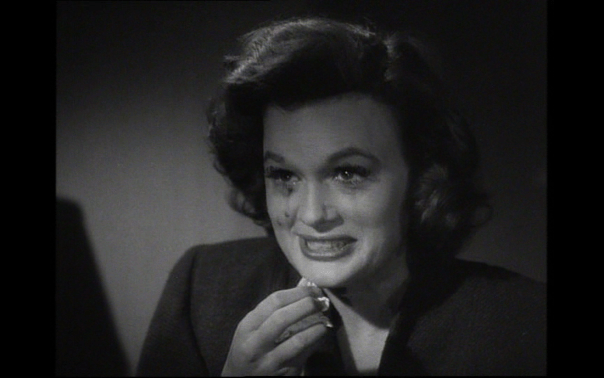I’ve seen this great heist film, one of the very darkest of noirs, before. What makes this noir different from all the others is that each character is not only mired in an underworld of greed, corruption and crime but also possessed of a kind of grace, be it Dix Handley’s (Sterling Hayden) code of honour in relation to his friendships and his dignity, or the kindness that’s at the core of Alonzo D. Emmerich’s (Louis Calhern) elegant putridness.
What struck me most this last viewing were the following:
a)It hadn’t quite registered before how striking and original are the compositions of the images in the film. I’ve included a selection below; everything is elegant but also off-kilter, like throwing a curve to the classical; motivated, expressive, almost standard; but by not quite being so making one see things afresh. Often, the camera is placed quite low so one’s always looking up at characters that loom but that are also hemmed-in by ceilings, lamps, shades, doorways
b)I was struck anew by Sterling Hayden’s handsomeness in this film. His Dix Handley is someone who once had it all but lost it, doing his best to get it back but also prone to quick excitement and danger, making a quick buck with a gun but losing it just as quickly on the track. The scar on his face a symbol of the scars he carries inside. The combination of Hayden’s handsomeness, the sadness in his eyes, and the elegant resignation of his bearing evoke fatality (see below). A man dreaming of the fields and horses of his youth but taking a detour on the road to nowhere.
c) Seeing Marilyn Monroe, in one of the first roles in which she made an impression — the other this same year was as a graduate of the Copacabana School of Acting in All About Eve — one is struck again by her charisma. She commands attention and gives this odd impression of being at once amateurish, inept — her line readings are hesitant, artificial — and authentic; of completely being that young girl using herself up with old men who can buy her the things she hopes will make her happy. She’s both fake and real, and at each instance sparks a dialectic where through the falseness she evokes something real and true, the surface but a pathway to depth.

d)I’d forgotten that the ‘Doll’ in the film is played by Jean Hagen, later to be everybody’s favourite character from Singing ‘in the Rain, the immortal Lina Lamont (‘I caiiin’t staaanhd it’). If, like I, you’ve wondered why the purveyor of such a great performance never became a star, you’ll find your answer here. Her ‘Doll’ is needy, loyal, desirious. The film gives her great moments, like the one below where she turns to Dix and takes her eyelashes off. But she also comes across as studied, and artificial, she’s ‘acting’ her carefully considered performance and comes across as too much and too coarse next to Haydn’s pointillism. She’s a better actress than Monroe but her ‘Doll’ comes across as less authentic, real and believable than Monroe’s Angela Phinley.

e) What struck me anew watching the film is how beautifully fleshed out all the supporting characters are. Thus Louis Ciavelli (Anthony Caruso) is not only a safe-cracker but a family man with a child that’s ill and a wife who wants him out of the game. Good at his job, part of a large extended Italian family, a guy who’s kept awake nights by the health of his baby and not by the dangers of his profession. Or Dix’s pal, Gus Minissi (James Whitmore), not only loyal to a fault but strong also, protective of the weak (his kicking out of the truck-driver who hates cats); victim of a life-long derision and abuse due to his being a hunchback (the conversation with Ciavelli’s wife) and putting his whole body into railing against injustice (the jail scene). Each character is given so many facets that when they come to the fore in the moments they´re given, they do so on top of carefully textured depth and evoke a character in a world that is connected to but also distinct from the film’s main narrative. Of these, the one that stands out most is Sam Jaffe’s Doc Irwin Riedenschneider, the mastermind of the heist: intelligent, cool, a man who goes about his business weighing the odds calmly until distracted by a pretty girl. The role and Sam Jaffe’s performance of it are surely one of the treasures of film history.

f) The last thing I wanted to comment on here was the symbolism of the final shot. The whole film has taken place at night, in the darkness, viewed only through shafts of light, in the city, the Asphalt Jungle. Dix’s drive has been to return home, to the horse and the farm that were taken away from him. He admits this history to Doll, this past that’s sparked a longing much stronger than his for her, a desire for a place — whether she’s in it is by the bye –a quarter of the way through the film. The only moment of greenery and light is in that shot. He reaches the farm only to die on it, the horses that were his dream and his friends, now licking his corpse. Is it heavy-handed? I don’t think so. For Dix what drove him into the Asphalt Jungle was that loss, regaining the farm and the horses has been what’s propulsed him through the narrative; and in a world where there’s no way out, it makes sense that the only way he’ll reach that farm is as a corpse.

The Asphalt Jungle gets greater with each viewing.
José Arroyo












